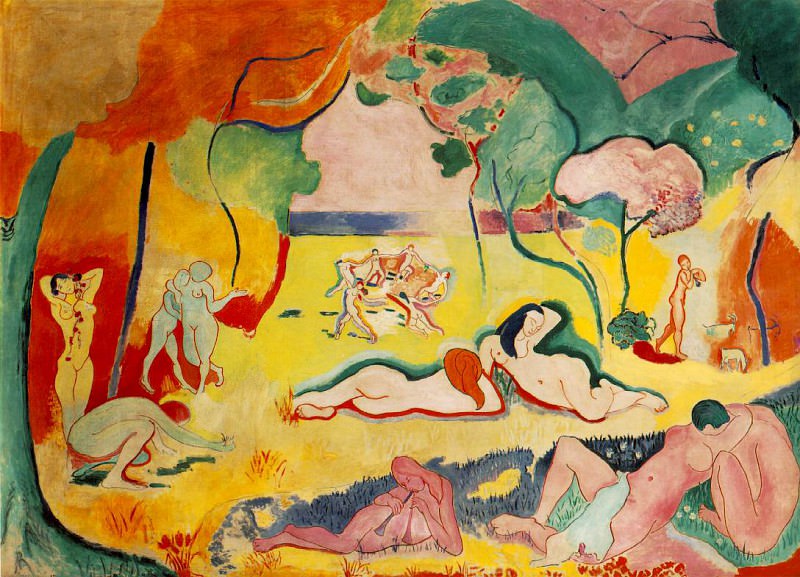Le bonheur de vivre (The Joy of Life), 1905-1906, 17 Henri Matisse (1869-1954)
Henri Matisse – Le bonheur de vivre (The Joy of Life), 1905-1906, 17
Edit attribution
Download full size: 1088×784 px (0,1 Mb)
Painter: Henri Matisse
In March 1906 the second exhibition of the representatives of Fauvism was held. It was impossible not to notice the striking large painting by the Fauvist leader Henri Matisse, entitled "Joy of Life". The artist had begun to work on it the year before, staying in the south of France. Having gained impressions in a sunnier part of the country, Matisse went to implement the born ideas in a new studio.
Description of the painting "The Joy of Life" by Henri Matisse
In March 1906 the second exhibition of the representatives of Fauvism was held. It was impossible not to notice the striking large painting by the Fauvist leader Henri Matisse, entitled "Joy of Life". The artist had begun to work on it the year before, staying in the south of France.
Having gained impressions in a sunnier part of the country, Matisse went to implement the born ideas in a new studio. The room he rented in an abandoned monastery was very spacious, and this certainly had an impact on the masterpieces he created there.
The freedom of space inspired the freedom of thought. "The Joy of Life, a canvas over two meters in width, is entirely new in style, not only to Matisse himself, but to fine art in general. Its distinctive features are as follows: large areas are painted in one color, figures are underlined with distinct bold lines, the nature of the image is similar to Persian miniatures and Japanese engravings.
The French painter skillfully conveyed a whirlwind of emotions through the play of color and modifications of forms. "The Joy of Life" combines motifs of unrestrained bacchanalia with the serenity of the pastoral. The nude figures of men and women are evenly distributed across the lower half of the canvas.
Surprisingly, the artist has chosen not to always adhere to the rule of perspective: the figures of different sizes are on the same level. Such a technique makes one get lost in the space of the painting. Like a sweet colored illusion, it engulfs the eye, clinging to the figures of dancing, musing and embracing couples in love.
The sky, sea, beach and dense trees serve as a backdrop for the resting people. Spots of bluish hues, greens, oranges and dazzling yellows bring harmony and a sense of celebration to the soul.
At the exhibition "The Joy of Life" was purchased by a collector from America, Leo Stein. Now the canvas is exhibited in the U.S. at the Barnes Gallery.
Кому понравилось
Пожалуйста, подождите
На эту операцию может потребоваться несколько секунд.
Информация появится в новом окне,
если открытие новых окон не запрещено в настройках вашего браузера.
You need to login
Для работы с коллекциями – пожалуйста, войдите в аккаунт (open in new window).



















You cannot comment Why?
Le Bonheur de Vivre (The Joy of Life) by Henri Matisse is a vibrant and expressive oil on canvas painting that depicts a pastoral scene filled with nude figures enjoying a leisurely existence. The artwork is characterized by its bold use of color, flattened forms, and a sense of rhythmic movement. Dominated by a palette of bright yellows, oranges, reds, and greens, the painting evokes a feeling of warmth, sensuality, and liberation.
In the foreground, several nude figures are shown in various states of repose and interaction. Some lounge languidly on the sun-drenched grass, while others are intertwined in intimate embraces or engaged in playful gestures. A group of figures in the mid-ground dances in a circle on a patch of yellow grass, their elongated limbs and simplified shapes conveying a joyful and unrestrained energy. In the background, a serene blue sea meets a pale sky, bordered by lush green hills and trees rendered in bold, undulating lines.
The painting is notable for its departure from traditional naturalism, with Matisse employing color to express emotions and sensations rather than to realistically depict the external world. The figures are not anatomically precise but are instead simplified and stylized, contributing to the overall sense of freedom and spontaneity. The landscape itself is also abstracted, with areas of flat color and flowing outlines creating a dreamlike and idyllic setting.
The subtexts of Le Bonheur de Vivre revolve around themes of hedonism, freedom, and the celebration of the human form and its connection to nature. The title itself, The Joy of Life, directly points to the paintings underlying message of embracing pleasure and living in harmony with oneself and the environment.
The abundance of nude figures can be interpreted as an expression of uninhibited sensuality and naturalness, free from societal constraints and moral judgment. They represent a return to a more primitive and instinctual state of being, where bodily pleasure and connection are paramount. The idyllic setting, often referred to as a paradise regained,Further underscores this idea of a perfect, uncorrupted existence.
Moreover, the painting can be seen as a rejection of the materialism and anxieties of modern urban life, offering instead a vision of spiritual and physical fulfillment through immersion in nature and the simple pleasures of human companionship. Matisse sought to create an art that would uplift and inspire, and Le Bonheur de Vivre stands as a powerful testament to his desire to capture and convey the essence of pure, unadulterated happiness. The work is a cornerstone of Fauvism, a movement that championed the expressive power of color and emotional intensity in art.